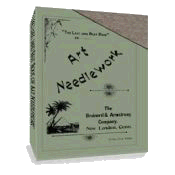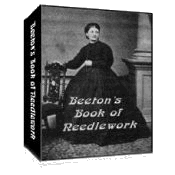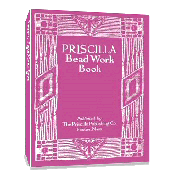The Best Flower Stem Stitches
(Flower Stem Stitches - Part 3 of "How to Embroider Flower Stems.)
Outline or Kensington Outline Stitch for Stems
The stem, — that is, one bearing a nodding flower without pronounced texture, and which is to be laid on linen, — should be expressed by the simplest and one of the most adequate of stitches, namely “Outline” or so-called “Kensington Outline.” See Colored Plate 1 – STEMS, B. This little flower stem stitch plays a very important part in embroidery and, though it is very generally known to needleworkers, it is not sufficiently well known as long as they are giving themselves extra work and arriving at unsatisfactory results by more elaborate processes. Illustration A (below) shows the use of this stitch and also the correct way to take it. It is safe to say that one may work all stems, which are expressed expressed by a single line in the design, on a material which can be held in the hand while working them, — that is not framed, by this method. How often this, and nothing more than this, should be used, may be judged by the proportion of flowers in the table under this head.

Click on picture to see more detail.
The deepest shade of the tone Green with which one is working should usually be the one with which the stems should be outlined. Frequently it is far better to do this than to introduce another color, especially a heavy one, such as for instance, the stems of which are almost Black.
Simple Outlining
Simple Outlining is a hand stitch and, because it is firm and fine, it should be the first part of the design to be worked before the piece is mounted. Whenever possible, long stems should be outlined from the direction of the least margin on the linen toward that of the greater, because a little pull over the knee of the weight of a centerpiece, for instance, serves to make it possible to lay the stitches firm.
Another point about an outlined stem is that it should come well up against the blossom it is intended to support. Because it is a lithe line, it must not be a weak one. Never outline carelessly with the expectation that the future work which you think will be more interesting will make up for the deficiency. The outlined stems in a design embroidered on linen are usually the unifying bond of work in color and stitching, even as they were so regarded by the designer and as they are in nature. The usual reason things are uninteresting and do not seem worth while is because people do not know enough abut them. The more we know of the possibilities of the little backstitch called “Outline,” the more our interest in it must increase.
The next stem to be considered is one which has decided width and is therefore to be shaded in order to appear round. This involves one of the primary laws of perspective which may be understood by anyone, viz — that a cylindrical form which takes light in front, will be light through the center or at its greatest projection and dark on both sides; or if the light comes from one side, it will be light on the side from which the light comes and dark on the other. Now how shall we express this most simply in stitchery? In the first case by covering the two outlines, which bound the width, each with a row of Simple Outline Stitches, in the deepest shade of silk, and leaving the linen uncovered to represent the high light. Colored Plate 1 – STEMS, J. and Illustration B of the morning glory stem below. In the second case by outlining one line dark and the other in a light shade. This make as tem of surprising strength, considering the lightness of the work, and simply because the light and shadow are suggested to the eye.

Click on picture to see more detail.
When the work is on purely conventional lines, a stem form may be expressed by rows of Outline, laid close together with a light shade of the silk in the center and dark on both sides of it. This is known as Bulgarian Stitch (See Illustration L below), and in this the light and shade are actually expressed; yet it will probably not seem as strong as the two lines, because in the one case the idea is worked out, and in the other the “feeling” or spirit of the idea is presented. Unless we can get hold of the feeling in some such way in our work, we must accept the dictum that embroidery is purely conventional and it is a violation of artistic sense to undertake to make it anything else.

Click on picture to see more detail.
Return to Part 1 Return to Part 2 Continue to Part 4
Return to top of Flower Stem Stitches Page
Return to Embroidery Instructions page.
Return to Home page.



 433 pages!
433 pages!

